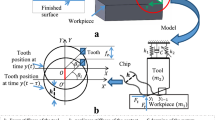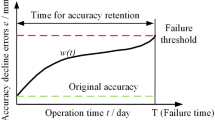Abstract
The choice of milling cutter geometry and appropriate cutting data for certain milling application is of vital importance for successful machining results. Unfavorable selection of cutting conditions might give rise to high load impacts that cause severe cutting edge damage. Under some circumstances the radial depth of cut in combination with milling cutter geometry might give unfavorable entry conditions in terms of cutting forces and vibration amplitudes. This phenomenon is originated from the geometrical features that affect the rise time of the cutting edge engagement into workpiece at different radial depths of cut. As the radial depth of cut is often an important parameter, particularly when machining difficult-to-cut materials, it is important to explore the driving mechanism behind vibrations generation. In this study, acceleration of the workpiece is measured for different radial depths of cut and cutting edge geometries. The influence of the radial depth of cut on the dynamical behavior is evaluated in time and frequency domains. The results for different radial depths of cut and cutting geometries are quantified using the root mean square value of acceleration. The outcome of this research study can be used both for the better cutting data recommendations and improved tool design.
Similar content being viewed by others
References
Altintas, Y., Analytical prediction of three dimensional chatter stability in milling, JSME Int. J. Ser. C, 2001, vol. 44, no. 3, pp. 717–723.
Budak, E., An analytical design method for milling cutters with nonconstant pitch to increase stability, Part I: Theory, J. Manuf. Sci. Eng., 2003, vol. 125, no. 1, pp. 29–34.
Diniz, A.E. and Filho, J.C., Influence of the relative positions of tool and workpiece on tool life, tool wear and surface finish in the face milling process, Wear, 1999, vol. 232, no. 1, pp. 67–75.
Ståhl, J.-E., Andersson, M., Bushlya, V., Zhou, J., Andersson, C., Högrelius, B., Gunnarsson, S., Schultheiss, F., Metal Cutting: Theories and Models., Lund, Sweden: Lund University Press, 2012.
Kuljanic, E., Sortino, M., and Totis, G., Multisensor approaches for chatter detection in milling, J. Sound Vib., 2008, vol. 312, no. 4–5, pp. 672–693.
Brandt, A., Noise and Vibration Analysis: Signal Analysis and Experimental Procedures., John Wiley & Sons, 2011.
Author information
Authors and Affiliations
Corresponding author
Additional information
The text was submitted by the authors in English.
About this article
Cite this article
Agic, A., Eynian, M., Hägglund, S. et al. Influence of radial depth of cut on entry conditions and dynamics in face milling application. J. Superhard Mater. 39, 259–270 (2017). https://doi.org/10.3103/S1063457617040062
Received:
Published:
Issue Date:
DOI: https://doi.org/10.3103/S1063457617040062




